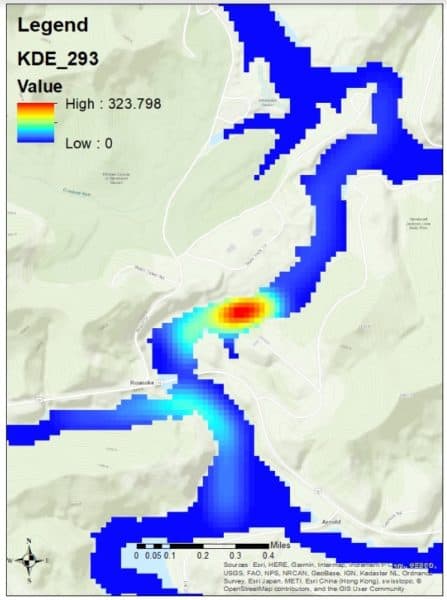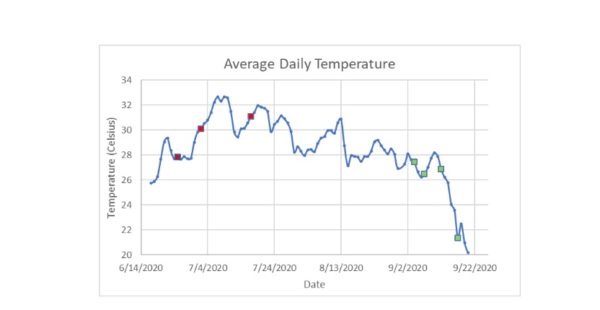Laymans Muskellunge Catch and Release Mortality Project Update 2020_2-25-2021
Category: article
Mar 25th, 2021 by Keith Worrall
Modified Mar 25th, 2021 at 1:12 PM
Muskellunge Catch and Release Mortality Project Update 2020
A total of 45 muskellunge were tagged in Stonewall Jackson lake. Two muskellunge tagged were over 50 inches in length weighing 32 lbs and 40 lbs. All 45 of the muskellunge have been located and were mobile after tagging. We attempted to track all 45 muskellunge each week from June 2nd through September 19th. On average we located 42 muskellunge each week. Each muskellunge was located an average of 12 time throughout the sampling period. We recorded a GPS location, surface temperature, dissolved oxygen and conductivity at each muskellunge location. Since Stonewall Jackson Lake stratifies and below the thermocline can be depleted of adequate oxygen to sustain muskellunge for long periods of time, we measured the depth at which the dissolved oxygen measurement dropped below 4 mg/l as well as the associated water temperature. This provided us with lowest possible water temperature that the muskellunge could live in based on their dissolved oxygen requirement. Additional data was collected starting April 6th biweekly locations were obtained, as well as locations gathered when directing anglers to target tagged muskellunge.
We received 23 angler recapture reports. Three reporters were unable to identify the individual tag number. A total of 10 recaptures occurred when surface water temperatures were above 80 degrees F. One of those recaptures died shortly after being caught, partially due to engulfing the bait and bleeding from the gills. The other 9 muskellunge have been mobile since their recapture event are assumed to be alive. Two of the uncaptured muskellunge have been relatively stationary and could potentially be deceased.
The study will continue in 2021, we plan to tag an additional 45 muskellunge with radio telemetry tags. We will still offer a $50 reward for angler reports of captured muskellunge during the summertime period from June through September. Other times of the year any recapture reports will receive an angler participation reward will be given along with information on the fish captured.
Some interesting observations from the project. One fish was captured a total of 3 times during 2020, once in May, November and December. Another fish was captured twice, once in April and once in August. Both fish of these multiple recaptured fish are mobile and assumed to be alive.

Figure 1. Kernel Density Estimate map for Muskellunge with Radio Tag 293. This map shows where Musky #293 spent most of its time during tracking in 2020. The warmer the color, the more time spent in that area.
Pond Study Palestine Hatchery (I. Taylor Booth thesis research):
Thirteen fish were stocked into pond #5 at the Palestine State Fish Hatchery in spring 2020. Lengths of fished ranged from 31.7 to 42.9 inches, and weights from 6.75 to 19.67 lbs. Catch and release data was collected from 7 fish in the pilot study for the pond mortality experiment. Water temperatures in the pond averaged 28.58 C (83.4 F) and reached a maximum of 34.57 C (94.22 F) in 2020 (Figure 2). Five fish perished throughout the duration of the study from 5/12/2020 – 11/4/2020. Three of the five fish that died were linked to catch and release events and perished within 2 weeks of being caught. Two control fish perished during the study. Based on these observations, catch and release mortality was 43% for caught and released fish and 33% for uncaught control fish. Angler catch per unit effort (CPUE) for the experiment was calculated and found to be 0.025 fish/hr (Table 1). CPUE at temperature <29.5 C (85.1F) increased to 0.04 fish/h, and dropped to 0.012 fish/h at temperatures >29.5 C (85.1 F). Catchability and overall susceptibility to angling seems to be negatively related with temperature from our preliminary analyses. This can be useful for managers to direct anglers to more productive areas as well as educate or dissuade Musky fisherman from targeting fish at increased temperatures due to increased mortality and reduced catchability.
The temperature was significantly higher for fish that died after being caught and released, than for surviving fish (p = .03768). No other relationships were found to be significant at this time but with more data we can improve statistical power and can better understand the effects increased temperature has on mortality rates to Musky. Increased sample size will also allow us to describe any relationships and interactions with fish size, fight time, and hook location. In 2021 state agencies in Virginia, North Carolina, Wisconsin, and Maryland have offered additional ponds and muskellunge from their respective waters. This brings our total up to 8 ponds that we can stock Muskellunge into for the 2021 field season, depending on fish availability from state agencies. This boost to the study will significantly increase our sample size and improve statistical power in further analyses.
Table 1. CPUE of Musky in Palestine State Hatchery Ponds


Figure 2. Average daily water temperature from the Palestine Hatchery Pond. Squares indicate catch and release events. Red squares are fish that perished within 2 weeks of the event; green squares are fish that survived.